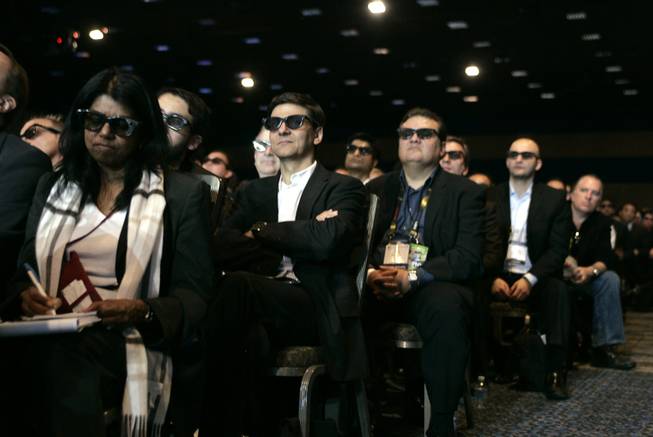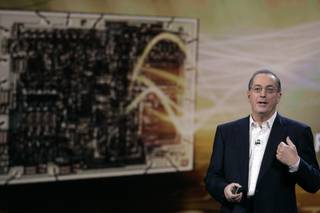
Leila Navidi / Las Vegas Sun
The audience watches a 3D demo wearing the Real D 3D glasses provided for Paul Otellini, president and CEO of Intel Corporation”s keynote address during the 2010 International Consumer Electronics Show at the Hilton Center in Las Vegas Thursday, January 7, 2010.
Friday, Jan. 8, 2010 | 2:05 a.m.
CES 2010: The Year of the 3-D TV
The 3-D TV may have been introduced at CES last year, but this year, some major companies are bringing it to market as early as this spring. A panel Wednesday summarized the major 3-D TV announcements from CES 2010. We asked viewers how they liked the experience and got a behind-the-scenes look at three of the hottest new models.
Related stories
- Industry working to clear up misconceptions about 3-D television (1-8-2010)
- Consumers want on-demand video, but media companies not delivering (1-8-2010)
- Ford unveils in-vehicle 'Touch' technology at CES (1-7-2010)
- Gadgets and garters: It’s convention in Las Vegas (1-7-2010)
- Puff of air controls new computer mouse (1-7-2010)
- Sony aims to become global leader in 3-D (1-7-2010)
- Microsoft anticipates 'biggest year ever' for the Xbox (1-6-2010)
- Las Vegas braces for 110,000 at Consumer Electronics Show (1-6-2010)
- Consumer Electronics hot ticket: 3-D television (1-6-2010)
- Analysts predict flat electronics sales for 2010 (1-6-2010)
- What others are saying about CES (1-6-2010)
Intel Corp. Chief Executive Officer Paul Otellini showed that the future of the fully connected home isn’t so far away.
Otellini showcased how Intel is helping users stay connected with their smartphones, TVs and computers during his keynote address Thursday night at the Consumer Electronics Show.
Intel execs demonstrated how they envision home devices working together in the future with connected PCs and TVs and a central organizational panel, which controls and tracks the energy use of virtually every device in the home.
“We believe these advances in technology are bringing a new era of computing,” Otellini said.
Intel, the world’s largest chip maker, is behind thousands of products on the CES show floor, and it was no surprise when Otellini showed the audience how Intel is involved with the show’s most talked about technology — 3-D.
The company is behind 3-D technology from the computing side, and as quality and technology advance, Intel’s role becomes even more vital.
Otellini said the new 3-D version of Shrek took more than 40 million rending hours while the original Shrek film, released in 2001, took just under 1 million hours.
Otellini said 3-D technology will eventually filter into the mainstream, making everyone a 3-D videographer.
Otellini, along with another Intel executive, demonstrated a scenario in which a family could use a 3-D stereoscopic camcorder and later add effects to the video in real time through editing software. The video can then be transferred to a 3-D-enabled TV and sharpened by 3-D glasses.
The Intel chief executive also unveiled Intel’s Light Peak technology, the next generation of content-sharing technology that will transfer data faster than ever before.
Light Peak will allow a user to download a Blu-Ray is less than 30 seconds. Otellini said we can expect all PCs to have the technology
Coming to store shelves even sooner is Intel’s Wireless Display. The technology lets users transfer high-definition content from their PC to TV seamlessly with only a wireless box. Otellini said Best Buy will have a selection of five laptops available with the capability next week.
Otellini showed off a smartphone based on a new version of the Atom chip, part of Intel’s strategy to break into the wireless-phone market. The phone runs on a chip called Moorestown and will be available through LG during first half of the year.
Continuing with the app craze, Intel announced its own app store, called the Intel AppUp Center, which lets consumers download applications for Atom-powered netbooks.
The second official day of CES will kick off on Friday with a keynote address from Nokia President and Chief Executive Olli-Pekka Kallasvuo.


Join the Discussion:
Check this out for a full explanation of our conversion to the LiveFyre commenting system and instructions on how to sign up for an account.
Full comments policy